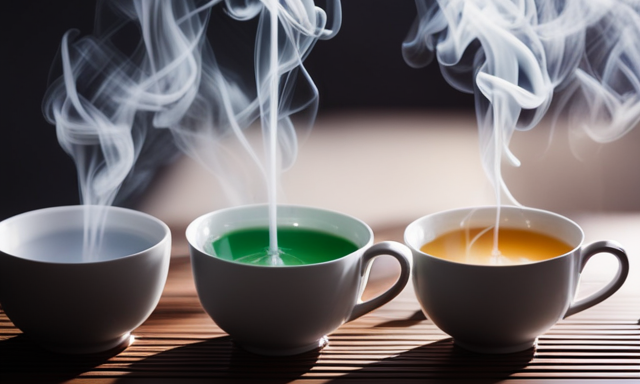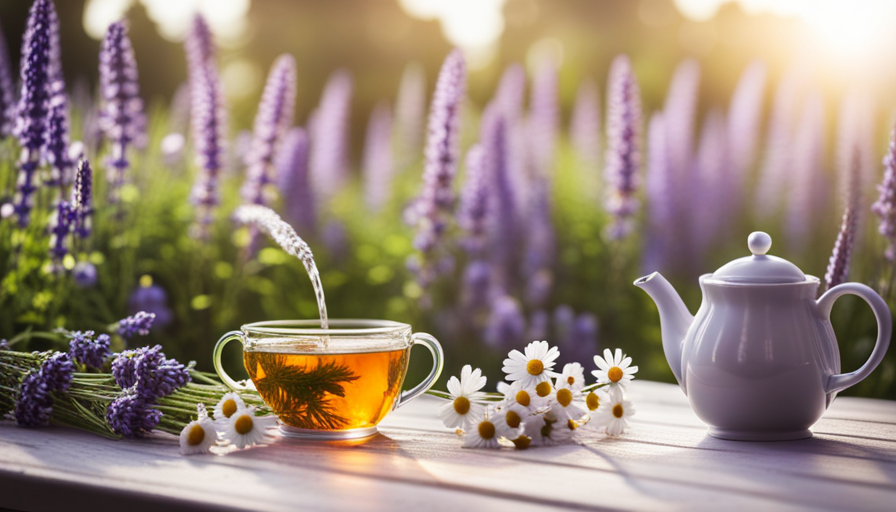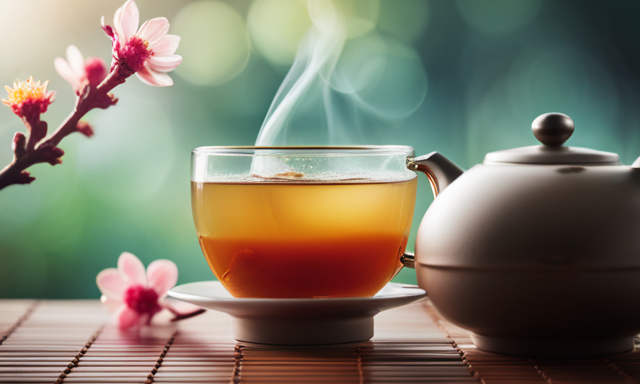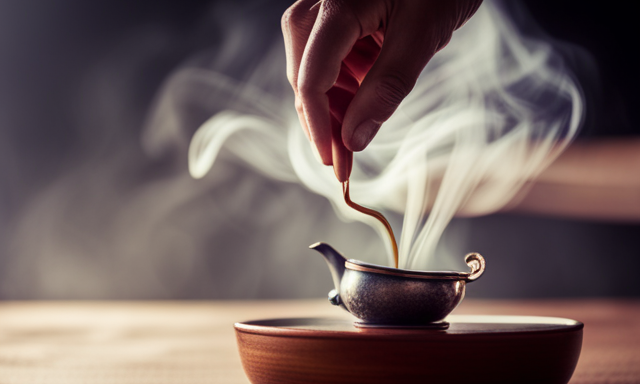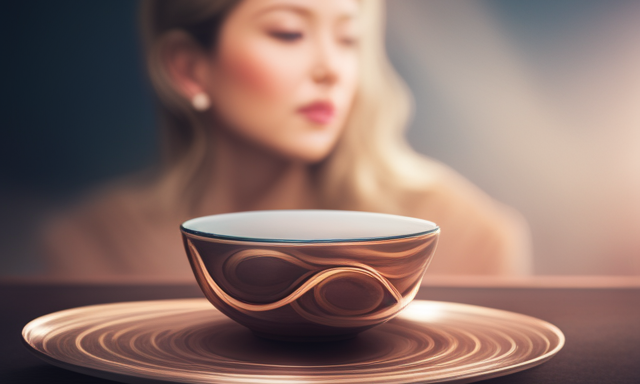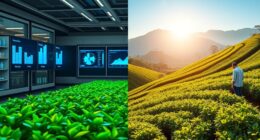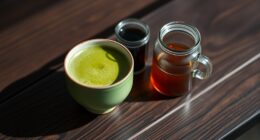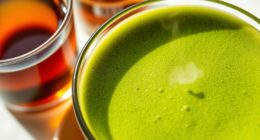As someone who loves tea, I have always thought that making the perfect cup of tea is an art. It’s like orchestrating a symphony, where each element must blend seamlessly to produce a delightful experience.
And just like a conductor carefully controls the tempo and dynamics of a musical piece, the temperature at which we brew our tea plays a crucial role in unlocking its true flavors and aromas.
In this article, we will explore the best temperatures for brewing white, green, and oolong tea bags. We’ll delve into the science behind tea temperature, discovering the ideal heat for each type of tea and the factors that affect it.
From the importance of water temperature to the art of experimenting with different degrees, we’ll equip you with the knowledge and tips to brew the perfect cup every time.
So, grab your favorite tea bags and get ready to embark on a journey of taste and precision.
Key Takeaways
- The best temperature for white tea is around 175°F (79°C) to preserve delicate flavors.
- Green tea thrives at a temperature range of 175-185°F (79-85°C) for grassy and vegetal notes.
- Oolong tea benefits from a temperature range of 185-205°F (85-96°C) for balanced floral and fruity undertones.
- Adjusting the temperature is crucial in tea brewing to bring out the best flavors and ensure a perfect cup.
Understanding Tea Temperature Basics
So, what’s the ideal temperature for brewing white, green, or oolong tea bags? Well, the water temperature plays a crucial role in extracting the flavors from these teas. Each type of tea requires a specific temperature to ensure optimal flavor extraction.
When brewing white tea, it’s best to use water that is around 175°F (80°C). This temperature allows for a delicate and subtle flavor profile to develop without overpowering the tea’s natural characteristics.
Now that we understand the importance of water temperature, let’s dive into the specifics of brewing white tea: the perfect temperature.
Brewing White Tea: The Perfect Temperature
Imagine stepping into a world of delicate flavors and subtle aromas, where a gentle warmth embraces the essence of your white tea, revealing its truest potential.
When it comes to brewing white tea, temperature control is crucial for achieving the perfect brewing. White tea is known for its delicate nature, and using the right temperature ensures that its flavors are not overwhelmed or diminished. The ideal temperature for brewing white tea is around 175°F (80°C). This allows the leaves to unfurl slowly, releasing their subtle flavors and aromas without becoming bitter.
By carefully controlling the temperature, you can unlock the full potential of your white tea and create a truly enjoyable experience.
Now, let’s explore how to achieve optimal flavor when brewing green tea.
Brewing Green Tea: Achieving Optimal Flavor
Steeping your green tea to perfection will result in a delightful infusion that captures the essence of its delicate flavors and aromatic nuances. Achieving optimal steeping is crucial to enhancing tea flavors and creating a truly enjoyable tea-drinking experience.
When it comes to green tea, the ideal temperature for steeping is around 175°F (80°C). This temperature allows the leaves to release their flavors gradually, avoiding any bitterness that can occur with higher temperatures. It’s important to note that different types of green tea may require slight variations in temperature, so it’s always a good idea to consult the packaging or instructions for specific guidelines.
By steeping green tea at the right temperature, you can unlock its full potential and savor its fresh, grassy notes.
Transitioning into the next section, let’s now explore the art of brewing oolong tea and finding the right heat.
Brewing Oolong Tea: Finding the Right Heat
To truly appreciate the complexities of oolong tea, one must master the precise art of finding the optimal heat for brewing. When brewing oolong tea, finding the right temperature is crucial to unlock its unique flavors and aromas. Here are three essential oolong tea brewing techniques:
-
Experiment with temperatures: Oolong tea can be brewed at various temperatures, ranging from 176°F (80°C) to 203°F (95°C). Start with a lower temperature and gradually increase it until you find the sweet spot that best suits your taste.
-
Steep with precision: To extract the full potential of oolong tea, steep it for 3-5 minutes. Longer steeping times can result in a more robust flavor profile, while shorter times may yield a milder taste.
-
Adjust for different oolong varieties: Different oolong teas may require slightly different temperatures. Lighter oolongs, like green oolong, often benefit from lower temperatures, while darker oolongs may require higher temperatures for a fuller-bodied brew.
Finding the right temperature is just the first step in brewing the perfect cup of oolong tea. Now, let’s explore the importance of water temperature in achieving tea perfection.
The Importance of Water Temperature
When it comes to brewing oolong tea, the key to achieving tea perfection lies in understanding the importance of water temperature. The role of water quality cannot be underestimated, as it directly affects the taste and aroma of the tea. Using filtered or spring water is recommended to ensure a clean and pure flavor. Steeping time also plays a crucial role in the final result. Different temperatures can extract varying levels of flavor and aroma from the tea leaves. To help you visualize this, here is a table showing the ideal water temperatures for brewing oolong tea:
| Tea Type | Water Temperature |
|---|---|
| White Tea | 175°F – 185°F |
| Green Tea | 160°F – 175°F |
| Oolong Tea | 190°F – 205°F |
By understanding the impact of water temperature, you can experiment with different temperatures to find the perfect brew.
Experimenting with Different Temperatures
If you’re looking to enhance your oolong tea experience, why not try experimenting with different water temperatures? Changing the brewing method can significantly affect the taste and aroma of your tea.
Here are three temperatures you can try:
-
Low Temperature: Brewing oolong tea at around 160°F (71°C) can bring out its delicate floral and fruity notes. The tea will have a lighter body and a more subtle taste.
-
Medium Temperature: Brewing oolong tea at around 180°F (82°C) strikes a balance between flavor and strength. This temperature brings out a mix of floral and earthy flavors, creating a well-rounded cup.
-
High Temperature: Brewing oolong tea at around 200°F (93°C) results in a stronger and bolder flavor profile. The tea may have a richer and more robust taste, with hints of roasted notes.
By experimenting with different brewing methods and comparing taste and aroma, you can find the perfect water temperature that suits your preference. Understanding the factors that affect tea temperature will further enhance your tea brewing experience.
Factors That Affect Tea Temperature
Experimenting with different temperatures is an essential part of finding the best brewing method for different types of tea. However, it’s important to understand the factors that affect tea temperature before conducting these experiments. Water temperature plays a crucial role in extracting the flavors and aromas from tea leaves. The temperature at which you steep your tea can significantly impact its taste and character.
To better understand the relationship between water temperature and tea brewing, let’s take a look at the following table:
| Tea Type | Ideal Water Temperature | Effects |
|---|---|---|
| White | 160-170°F (71-77°C) | Delicate flavors and subtle sweetness are enhanced |
| Green | 175-185°F (79-85°C) | Brings out grassy and vegetal notes, minimizes bitterness |
| Oolong | 190-200°F (88-93°C) | Unfolds complex flavors and floral aromas |
By carefully adjusting the water temperature, you can achieve the desired taste profile for each tea type. Now that we understand the effects of water temperature on tea, let’s explore some tips for brewing tea bags at the ideal temperature.
Tips for Brewing Tea Bags at the Ideal Temperature
To brew your tea bags at the perfect temperature, simply adjust the water to bring out the unique flavors and aromas of each type.
When it comes to brewing herbal tea, temperature guidelines are important to ensure optimal taste. Green tea, for example, should be brewed at a lower temperature of around 160-180°F (71-82°C) to avoid bitterness and preserve its delicate flavors. On the other hand, white tea requires a slightly higher temperature of 180-190°F (82-88°C) to fully extract its subtle flavors. Oolong tea falls somewhere in between, typically brewed at 190-200°F (88-93°C) to balance its floral and fruity notes.
It’s crucial to understand that the impact of temperature on tea flavor is significant, and adjusting it accordingly can result in a more enjoyable cup. By following these guidelines, you can experience the full potential of your favorite teas and savor the perfect cup every time.
Enjoying the Perfect Cup Every Time
Savoring the ideal cup of tea is like taking a sip of pure bliss, where every flavor note dances on your taste buds and transports you to a state of pure relaxation. To achieve this perfection, it’s crucial to master the art of tea brewing techniques and understand the unique flavor profiles of different teas.
When it comes to temperature, white tea is best brewed at around 175°F, which allows its delicate flavors to shine. Green tea, on the other hand, thrives at a slightly higher temperature of 175-185°F, bringing out its grassy and vegetal notes. Oolong tea, with its complex flavor profile, benefits from a temperature range of 185-205°F, striking a perfect balance between the floral and fruity undertones.
By brewing your tea at the ideal temperature, you can ensure a sublime tea experience every time.
Frequently Asked Questions
Can I use the same temperature for brewing all types of tea?
Different brewing temperatures for different types of tea are necessary. Each variety has an optimal brewing temperature to bring out its unique flavors and aromas. Using the same temperature may result in a subpar tea experience.
Is it possible to brew tea without a thermometer?
Brewing tea without a thermometer is like navigating a ship without a compass. It’s possible, but the risk of losing direction and ending up with a less flavorful cup is higher. Temperature plays a crucial role in brewing methods and impacts tea flavor.
How long should I let the water cool before brewing my tea?
To get the perfect cup of tea, it’s important to let the water cool to the right temperature. Different types of tea require different water temperatures to bring out their flavors. Steeping time also affects the flavor of the tea.
Can I reheat my tea if it has become too cold?
Yes, you can reheat tea if it has become too cold. However, it is important to note that reheating can affect the taste and quality of the tea. I can provide more information on tea temperature preferences if needed.
Does the temperature of the tea affect its health benefits?
Brewing tea at different temperatures affects its taste and health benefits. Higher temperatures extract more antioxidants, enhancing the tea’s health benefits. Just like a symphony of flavors, temperature plays a key role in unlocking the full potential of different teas.
Conclusion
In conclusion, finding the ideal temperature for brewing white, green, or oolong tea bags is crucial for achieving the perfect cup. Based on my research, the best temperature for white tea is around 175°F (80°C). Green tea is best brewed at 160-170°F (70-75°C). Oolong tea, on the other hand, requires a slightly higher temperature of 185-205°F (85-95°C) to bring out its unique flavors.
Interestingly, studies have shown that brewing tea at the right temperature can enhance its antioxidant properties by up to 5%. So, next time you brew a cup of tea, remember to pay attention to the temperature for a truly enjoyable and beneficial experience.

